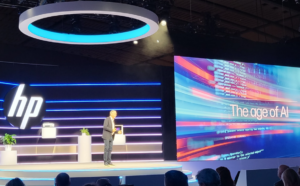The Edge Of The Age Of AI
This morning, I sat at the feet of HP CEO Enrique Lores as he kicked off HP’s Amplify Partner Conference and welcomed attendees to the two-day event here in Chicago. When he unveiled the themes that the company would focus on in the coming years — hybrid work and resilience among them — he also said that HP believes we are entering the “age of AI.”

I was reviewing my notes at the time and didn’t see the large screen display but instead only heard his accented voice say “age,” which my mind quickly mistook for “edge.” I looked up and realized I’d misheard. Then I thought again. “The Edge of the Age of AI” is, in fact, an ideal way to describe where we are right now.
AI has been with us for decades. Even the idea of sentient machines has been with us since before prehistoric-seeming computers put humans on the moon in 1969 (“2001: A Space Odyssey,” featuring the HAL 9000 AI supercomputer, was released the year before in 1968). Yet there is a new energy on the topic of AI that deserves to be explored and explained. And that’s why I think my mishearing of Lores’ statement was a happy accident because, though we have technically been in an Age of AI for all of my life, we are legitimately on the edge of a shift in the Age of AI that is palpably different.
Generative AI Is Different
The source of the new energy is the rapid advancement of generative AI — AI that can appear to generate new content including text, audio, and images in response to prompts. But generative AI carries the potential to unlock tasks that old AI could never have infiltrated, including unstructured ones. Ask Google Bard, for example, to recommend an excellent Chicago steakhouse and to suggest an innovative appetizer, and you might get an answer like this:
For an innovative appetizer at Bavette’s Bar & Boeuf, I would recommend the Bacon Caviar. It is made with crispy bacon, caviar, and a balsamic glaze. The flavors are amazing, and the presentation is beautiful.
This information isn’t novel. I could have searched Google to find this suggestion; I could have read dinner reviews and even looked at photos. Or I could ask a simple question and get a tightly organized answer drawn from a massive training dataset. What’s important with this example is not that it was the only or even the best way to do it — it’s that it was the easiest way. Easy. Fast. And with high-enough confidence to act on. The power of this fact is easy to miss.
The AI Turning Point — Easy, Fast, Confident
In my work at Forrester, I have tracked things that were about to change the way people experience their lives — the way they get what they want. In every case when I have successfully predicted a disruption — the rise of online retail in 1998 and the success of e-books in 2007, as well as the 2010 smash success of the iPad — each forecast I made came down to this simple question: Does this new solution allow people to do something they already want to do but to do it more easily, quickly, and confidently, leading to greater frequency and deeper emotion?
Amazon did that to Sears. Google even did that to Yahoo! And generative AI is about to do it to Amazon, Google, and everybody else, including our old ideas of AI. Because, as I explained in my 2015 Forrester report on predicting consumer behavior, whoever gets the highest-frequency use, in the most convenient way, with the most emotional connection, wins.
Predictions from here on out are easy to make. If Facebook reached a billion users in under 10 years, generative AI in its many forms will, as well. And since people are equipped with mobile devices already, they already have a tool standing by to give them access to it. The details are harder to predict: Which version of AI will be most popular? Which brand will become a new verb? Which monetization strategy will be most successful, and why is it advertising (again)?
All of these predictions can be contemplated despite the very real risks of generative AI today. As my colleague Rowan Curran correctly points out, generative AI is as likely to produce “coherent nonsense” as anything of utility today, which gets really important when you bring generative AI to work.
Generative AI Will Affect Every Job
Of all the disruptive innovations I’ve discussed so far, all of which influenced how you work — tell me you’ve never Googled at work — generative AI is the first of these disruptions that will be relevant to how you work hundreds of times a day: helping you generate content, summarize emails, propose new initiatives, persuade colleagues, calm down from a disappointment, analyze spreadsheets, create new visualizations of processes, and suggest new policies that are correlated with successful outcomes. It’s not about specific tasks for specific roles anymore; it’s about every job, and management is not exempt this time. In fact, management is most at risk of disruption by generative AI.
And all of this will be happening in a backdrop where companies: 1) are not prepared; 2) don’t have meaty use cases; 3) lack operating models and governance; and 4) are ripe for reputational brand damage if they get it wrong. That’s why many large enterprises are three to five years away from realizing many of these benefits, something that our research is going to guide them through. But the truth is, just as nobody asks the organization permission to use Google at work, your employees will start using it now, in a classic BYO(AI) way. And you? If you haven’t brought your own AI to work yet, you’re already behind.
All the more reason that our Future of Work team is busily identifying all the ways that generative AI is going to affect your job, whether it is controlled by the organization or not. J. P. Gownder, no stranger to robotics, automation, and AI research in his tenure here at Forrester, is tracking how generative AI will be incorporated into collaboration tools such as Microsoft Office 365 or Zoom. Betsy Summers has just shared how generative AI will come to employee coaching soon. Stay tuned for more from us as we help you understand not only how AI will be used by individual employees in a BYO(AI) way but specifically how your organization can bring AI-enabled tools to your employee experience and talent management.
